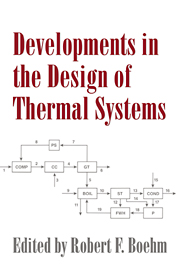Book contents
- Frontmatter
- Contents
- Preface
- Biographical sketches of the authors
- 1 Introduction and trends in the thermal design field
- 2 Computer-aided process design trends in the power industry
- 3 Automated design of chemical process plants
- 4 Thermophysical properties for design simulations
- 5 Introduction to Pinch Analysis
- 6 Second Law applications in thermal system design
- 7 Thermodynamic optimization of heat transfer and fluid flow processes
- 8 An introduction of thermoeconomics
- 9 Artificial intelligence in thermal systems design: concepts and applications
- Subject Index
- Author Index
4 - Thermophysical properties for design simulations
Published online by Cambridge University Press: 23 September 2009
- Frontmatter
- Contents
- Preface
- Biographical sketches of the authors
- 1 Introduction and trends in the thermal design field
- 2 Computer-aided process design trends in the power industry
- 3 Automated design of chemical process plants
- 4 Thermophysical properties for design simulations
- 5 Introduction to Pinch Analysis
- 6 Second Law applications in thermal system design
- 7 Thermodynamic optimization of heat transfer and fluid flow processes
- 8 An introduction of thermoeconomics
- 9 Artificial intelligence in thermal systems design: concepts and applications
- Subject Index
- Author Index
Summary
Introduction
The keystone of the design of a thermal system or any other chemical process is the process simulation program. Quoting Cox (1993), “All correlations, theories, and physical property data must be translated into computer terms before they truly become useful for chemical process design applications. Data banks and associated physical property models form the heart of any computer simulator calculation.” The quality of these data modules can have extensive effects. Inaccurate data may lead to costly errors in judgment whether it is to proceed with a new process or modification or not to go ahead. Inadequate or unavailable data may cause a potentially attractive and profitable process to be delayed or rejected because of the difficulty or impossibility of properly simulating it. Even the most sophisticated software will not lead to a cost-effective solution if it is not backed up by an accurate database. The ability to effectively conserve energy in many processes is related directly to the accuracy of the physical and thermodynamic data available.
A number of projects, frequently funded by consortia of companies and government agencies, exist for the collection and evaluation of data concerning particular areas of interest: chemical processing, electric and gas production and distribution, biology, medicine, geology, meteorology, music, demographics, etc. This chapter will address the phase equilibrium, thermodynamic data, and physical properties generally required in the design of thermal and chemical processing systems.
- Type
- Chapter
- Information
- Developments in the Design of Thermal Systems , pp. 76 - 121Publisher: Cambridge University PressPrint publication year: 1997



